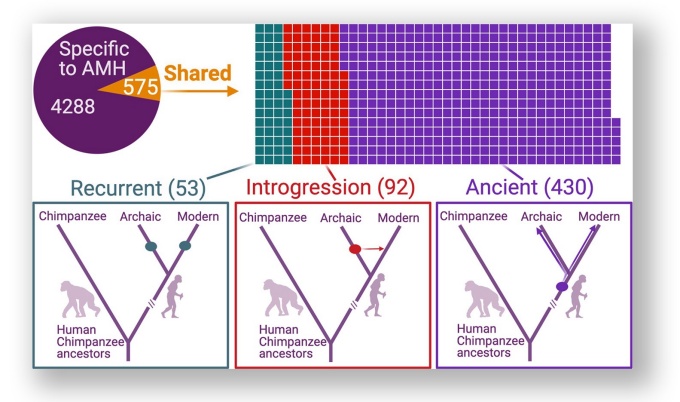eLife publishes "Balancing selection on genomic deletion polymorphisms in humans"

The eLife paper includes the image, titled, Deletions in anatomically modern humans (AMHs) that are shared with archaic hominins.
Alber Aqil, PhD candidate, and Prof Omer Gokcumen are co-authors of a research paper that examines a key question in biology: why genomic variation persists in a population for extended periods. Recent studies have identified examples of genomic deletions that have remained polymorphic in the human lineage for hundreds of millennia, ostensibly owing to balancing selection. Nevertheless, genome-wide investigation of ancient and possibly adaptive deletions remains an imperative exercise. Their research demonstrates an excess of polymorphisms in present-day humans that predate the modern human-Neanderthal split (ancient polymorphisms), which cannot be explained solely by selectively neutral scenarios. The eLife paper is here. Read the research news article by Corey Nealon.
research news
Gene variations for immune, metabolic conditions have persisted in humans for more than 700,000 years

Homo neanderthalensis adult male. Reconstruction based on Shanidar 1 by John Gurche for the Human Origins Program, NMNH. Date: 225,000 to 28,000 years.
By CORY NEALON
Published February 23, 2023
Like a merchant of old, balancing the weights of two different commodities on a scale, nature can keep different genetic traits in balance as a species evolves over millions of years.
These traits can be beneficial (for example, fending off disease) or harmful (making humans more susceptible to illness), depending on the environment.
The theory behind these evolutionary trade-offs is called balancing selection. A UB-led study published Feb. 21 in eLife explores this phenomenon by analyzing thousands of modern human genomes alongside ancient hominin groups, such as Neanderthal and Denisovan genomes.
The research has “implications for understanding human diversity, the origin of diseases and biological trade-offs that may have shaped our evolution,” says evolutionary biologist Omer Gokcumen, the study’s corresponding author.
Gokcumen, associate professor of biological sciences, College of Arts and Sciences, adds the study shows that many biologically relevant variants “have been segregating among our ancestors for hundreds of thousands, or even millions, of years. These ancient variations are our shared legacy as a species.”
Ties with Neanderthals stronger than previously thought
The work builds upon genetic discoveries in the past decade, including when scientists uncovered that modern humans and Neanderthals interbred as early humans moved out of Africa.
It also coincides with the growth of personalized genetic testing, with many people now claiming that a small percentage of their genome comes from Neanderthals. But, as the eLife study show, humans share much more in common with Neanderthals than those small percentages indicate.
This additional sharing can be traced back to a common ancestor of Neanderthals and humans that lived about 700,000 years ago. This common ancestor bequeathed to the Neanderthals and modern humans a shared legacy in the form of genetic variation.
The research team explored this ancient genetic legacy, focusing on a particular type of genetic variation: deletions.
Gokcumen says the “deletions are strange because they affect large segments. Some of us are missing large chunks of our genome. These deletions should have negative effects and, as a result, be eliminated from the population by natural selection. However, we observed that some deletions are older than modern humans, dating back millions of years ago.”
Gene variations passed down over millions of years
The researchers used computational models to show an excess of these ancient deletions, some of which have persisted since our ancestors first learned to make tools, some 2.6 million years ago. Furthermore, the models found that balancing selection can explain this surplus of ancient deletions.
“Our study contributes to the growing body of evidence suggesting that balancing selection may be an important force in the evolution of genomic variation among humans,” says first author Alber Aqil, a PhD candidate in biological sciences in Gokcumen’s lab.
The investigators found that deletions dating back millions of years are more likely to play an outsized role in metabolic and autoimmune conditions.
Indeed, the persistence of versions of genes that cause severe disease in human populations has long baffled scientists since they expect natural selection to get rid of these versions of genes. It is, after all, very unusual for potentially disease-causing variation to persist for such long periods. The authors argue that balancing selection can solve this riddle.
Aqil says these variations may “protect against infectious diseases, outbreaks and starvation, which have occurred periodically throughout human history. Thus, the findings represent a considerable leap in our understanding of how genetic variations evolve in humans. A variant may be protective against a pathogen or starvation while also underlying certain metabolic or autoimmune disorders, like Crohn’s disease.”
Additional co-authors include Leo Speidel, Sir Henry Wellcome Postdoctoral Fellow at the Genetics Institute of University College London and the Francis Crick Institute, and Pavlos Pavlidis of the Institute of Computer Science, one of eight institutes of the Foundation of Research and Technology-Hellas in Greece.
The research was supported by the National Science Foundation, the Sir Henry Wellcome Fellowship, and the Wellcome Trust.
Faculty Profile
![Omer Gokcumen.]()
Omer Gokcumen
PhD
ProfessorMeyerson Award for Undergraduate Mentoring, 2025Distinguished Postdoc Mentor Award, 2019Research Interests
Human and primate evolution, ancient humans (including Neanderthals and Denisovans), anthropological genomics
Education
- PhD, University of Pennsylvania
- Postdoctoral Research, Harvard Medical School
Research Statement
Omer Gokcumen is an expert in evolutionary anthropology — the study of how humans evolved and how they differ from non-human primates such as gorillas and chimpanzees. His work is tied to human evolution, including evolutionary adaptation and the evolutionary processes that lead to genetic disease.
Gokcumen’s research examines the role that genomic variants, especially deletions and duplications, play in human disease and biology. His laboratory investigates the evolutionary history of genetic variations tied to interesting traits and diseases in modern and ancient human populations.
- 2022 Interview for BBC 4 - Inside Science on our work on evolution of mucus. (here)
- 2022 Interviewed for NPR - RadioLab. “Neanderthals’ revenge” episode on our work on ancient alleles in the human genome. (here)
- 2021 Interviewed for Scientific American on our work on the evolution of human growth hormone receptor. (here)
- 2021 Interviewed for The Scientist on our work on the evolution of human growth hormone receptor. (here)
- 2021 Quoted in How Stuff Works - “How human are humans?” by Joanna Thompson. (here)
- 2020 BBC - Reel
- 2019 Quoted in NYTimes.
- 2022 Pajic et al. A mechanism of gene evolution generating mucin function. Press release. Selected highlights: New Scientist, Yahoo News, BBC, GEN, Inverse.
- 2021 Saitou et al. Sex-specific phenotypic effects and evolutionary history of an ancient polymorphic deletion of the human growth hormone receptor. Press release. Selected highlights: Real Clear Science, The Scientist, Scientific American.
- 2020 Saiotu et al. Functional Specialization of Human Salivary Glands and Origins of Proteins Intrinsic to Human Saliva. Press release. Selected Highlights: Cosmos, CBC- Radio Active.
- 2020 Taskent et al. Analysis of haplotypic variation and deletion polymorphisms point to multiple archaic introgression events, including from Altai Neanderthal lineage. Press release. Selected Highlights: Futurity, Sputnik, Genetic Literacy Project.
Selected Publications
- Yilmaz, F., Karageorgiou, C.*, Kwondo, K., Pajic P.*, Scheer, K.*, HGSV Consortium, Beck, C., Torregrossa, A-M., Lee, C., Gokcumen, O.* (2024). Reconstruction of the human amylase locus reveals ancient duplications seeding modern-day variation. Science. 386: eadn0609
- Russel, M., Aqil, A*., Saitou, M., Gokcumen, O*, Naoki, M. (2023) Gene communities in co-expression networks across different tissues. PloS Computational Biology. 19(11): e1011616. [co-Corresponding Author].
- Veilleux, C.C., Garrett, E.C., Pajic, P.*, Saitou, M.*, Ochieng, J., Dagsaan, L.D., Dominy, N.J., Perry, G.H., Gokcumen, O.*, Melin, A.D. (2023). Veillex Human subsistence and signatures of selection on chemosensory genes. Communications Biology. 6: 683. [co-Corresponding Author].
- Aqil, A.*, Pavlos, P., Speidel, L. Gokcumen, O.* Balancing selection on genomic deletion polymorphisms in humans. (2023). eLife. e79111
- Pajic, P.*, Shen, S., Qu, J., May, A.J., Knox, S., Ruhl, S., Gokcumen, O.* (2022) A mechanism of gene evolution generating mucin function. Science Advances. 8: 34.
- Saitou, M.*, Masuda, N., Gokcumen, O.* (2022). Similarity-based analysis of allele frequency distribution among multiple populations identifies adaptive genomic structural variants. Molecular Biology and Evolution. 39: msab313.
- Saitou, M.*, Resendez, S.*, Pradhan, A.J., Wu, F., Lie, N.C., Hall, N.J., Zhu, Q., Reinholdt, L. Satta, Y., Speidel, L., Nakagome, S., Hanchard, N. A., Churchill, G., Lee, C., Atilla-Gokcumen, G. E., Mu, X., Gokcumen, O.* (2021). Sex-specific phenotypic effects and evolutionary history of an ancient polymorphic deletion of the human growth hormone receptor. Science Advances. 7, eabi4476.
- Saitou, M.*, Gaylord, E., Xu, D., Neznanova, L., Nathan, S., Grawe, A., Chang, J., Ryan, William., Ruhl, S., Knox, S.M., and Gokcumen, O.* (2020). Functional Specialization of Human Salivary Glands and Origins of Proteins Intrinsic to Human Saliva. Cell Reports. 33, 108402.
- Taskent, O.*, Yen Lung Lin, Patramanis, I., Pavlidis, P., Gokcumen, O.* (2020). Analysis of haplotypic variation and deletion polymorphisms point to multiple archaic introgression events, including from Altai Neanderthal lineage. Genetics. 215: 497-509.
- Pajic, P.*, Pavlidis, P., Dean, K., Neznanova, L., Daugherity, E., Romano R-A., Garneau, D., Globig, A., Ruhl, S., Gokcumen, O.* (2019). Independent amylase gene copy number bursts correlate with dietary preferences in mammals. eLife.
- Lin, Y.-L.*, & Gokcumen, O.* (2019). Fine-Scale Characterization of Genomic Structural Variation in the Human Genome Reveals Adaptive and Biomedically Relevant Hotspots. Genome Biology and Evolution, 11(4), 1136–1151.
- Saitou, M.*, Lizardo, D., Taskent, R. O.*, Millner, A., Gokcumen, O.*, Atilla-Gokcumen, G. (2018). An evolutionary transcriptomics approach links CD36 to membrane remodeling in replicative senescence. Mol Omics 14, 237 [Cover article, co-Corresponding Author].
- Xu, D.*, Pavlidis, P., Taskent*, R.O., Alachiotis, N., Flanagan. C.*, DeGiorgio, M., Ruhl, S., Gokcumen, O.* (2017). Archaic hominin introgression in Africa contributes to functional salivary MUC7 genetic variation. Mol Biol Evol. 34: 2704


